How to Photograph Fireworks – Everything You Need to Know
Photographing fireworks is a challenging, but worthwhile experience
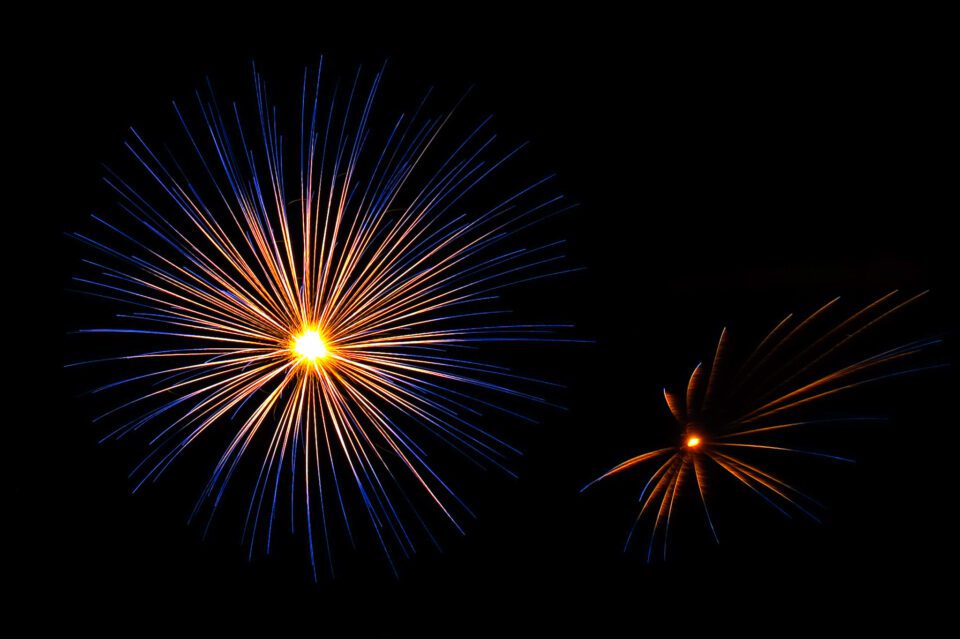
How to Photograph Fireworks
What to Bring
Although you can certainly photograph fireworks with very minimal gear, you might want to go over the list of the recommended gear and accessories below while packing for a fireworks show:- Camera – any point-and-shoot, DSLR or mirrorless camera will do, as explained in camera considerations step below.
- Lens(es) – ideally, you might want to bring two zoom lenses with you, such as a 24-70mm and 70-200mm equivalent, as explained in lens considerations step below.
- Tripod – a must-have piece of gear to take camera shake-free images of fireworks.
- Remote Shutter Release – while not required, a remote shutter release will allow you to take pictures in “Bulb” exposure mode, as explained in step #10 below.
- Memory Card(s) – don’t forget to pack at least one empty memory card (preferably more if you end up taking lots of images).
- Spare Battery – just in case, you might want to take a spare battery, especially if you are going to be shooting in cold weather, since low temperatures drain camera batteries quickly.
- Flashlight – you might need a flashlight not just to see the buttons and dials of your camera, but also to be able to properly focus on a foreground subject.

Find the Best Location to Photograph Fireworks
The first thing you need to determine is where exactly you are going to stand to photograph fireworks. I would not recommend standing too close to fireworks, because you will be constantly looking up and you might not be able to find a suitable and interesting foreground to incorporate in your shots. In addition, if you are too close, you might need a wide-angle lens to fit the action into the frame. This might present another problem – you might end up including unwanted objects like buildings and trees into the frame (unless, of course, it is your plan to do so).Therefore, the best thing to do is to stand further away in an open area (with short or no trees obstructing the view). Ideally, you should stand at a spot that gives you a maximum of 45 degrees view angle relative to the ground, as shown in the diagram below:
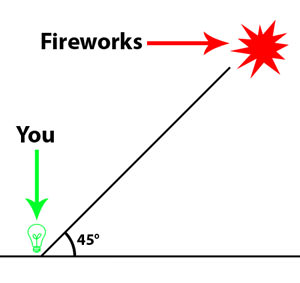
The further you stand when you photograph fireworks, the lower the angle and the more focal length you might need. Obviously, each situation is different, so just try to find a good spot with clear views of the sky in an open, unobstructed area that can give you a nice angle to photograph the fireworks.
Ideally,
you should be at the spot early on. It is helpful to know exactly where
the fireworks will be shot from, so that you can frame and compose your
shot exactly the way you want. Don’t forget that fireworks draw a lot
of people, so even if you pre-plan and work on your composition, you
might need to adjust it later on. I personally have found that unless I
am standing at a higher elevation, with no potential of anyone standing
in front of me, I am always better off excluding the foreground
completely. Once the fireworks start, you will have a hard time asking
people to move just because they are in your shot.
Choose the Right Camera
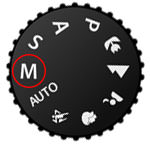 The good news is that you don’t need an expensive camera to photograph fireworks. Any camera that allows shooting in manual mode
will work perfectly fine! Many of the point and shoot cameras do, so
double check your manual and see how you can switch to manual mode.
The good news is that you don’t need an expensive camera to photograph fireworks. Any camera that allows shooting in manual mode
will work perfectly fine! Many of the point and shoot cameras do, so
double check your manual and see how you can switch to manual mode.Another good thing about shooting fireworks, is that you will be most likely shooting at the lowest ISO levels, which means that there will be very minimal amounts of noise in your images. So you don’t have to worry about your camera’s capabilities, besides being able to switch to manual mode and lowering your ISO to 100. If you have a DSLR or a mirrorless camera, you are all set, because you can do all this quickly and painlessly. Some cameras even have a “Fireworks Mode”, which works great and does not require you to change any settings on the camera.
Choose the Right Lens(es)
If you have a point and shoot camera, make sure that its lens can do at least 5x optical zoom (not digital). Optical zoom means that the camera lens will physically move to get more reach, while digital zoom means that the camera will simply cut out the image corners to make it seem like you are closer. With optical zoom, you are not compromising image resolution, whereas with digital you are.If you have a DSLR or a mirrorless camera, you might wonder what lens to take with you to photograph fireworks. I have shot fireworks for many years and I find that telephoto zoom lenses such as 70-200mm or 70-300mm equivalent work best for fireworks, especially if you are going to be shooting from a nice vantage point, with fireworks exploding in the distance. If you are going to be shooting up from a relatively close distance, then a wide to telephoto lens, such as a 24-70mm or a 24-120mm equivalent is going to work best. You don’t need a large aperture prime lens to shoot fireworks – a zoom lens is ideal, since you can fine tune your framing without having to physically move anywhere. Personally, whenever I plan on shooting fireworks, I typically bring two such zoom lenses with me.
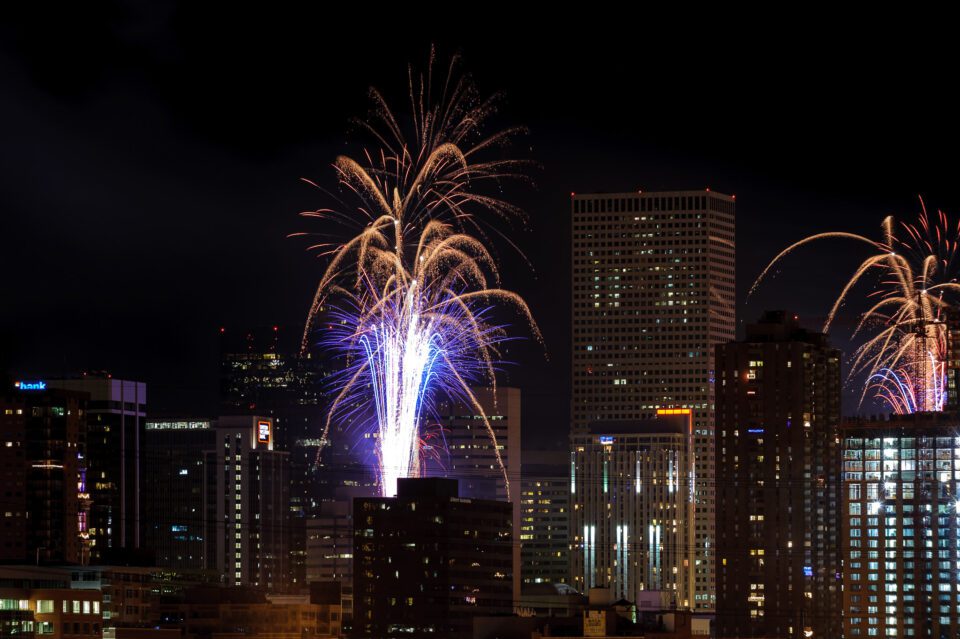
A telephoto zoom lens proved to be useful to have for the above shot. Initially, I captured the image at a shorter focal length of 105mm, which allowed me to include a bit more of the foreground:

That’s
why a zoom lens is a versatile option – you can try different framing
options and have a better control over your composition.
Use a Tripod
It goes without saying that in order to properly capture fireworks and frame your shots, you will need to have a tripod. You will be taking shots that will be several seconds long, so having your camera on a tripod is going to be ideal for best results. The good news is, you won’t need a fancy tripod to take great shots of fireworks. Since exposure times are going to be rather long, make sure to grab a remote shutter release as well to keep your hands off your camera.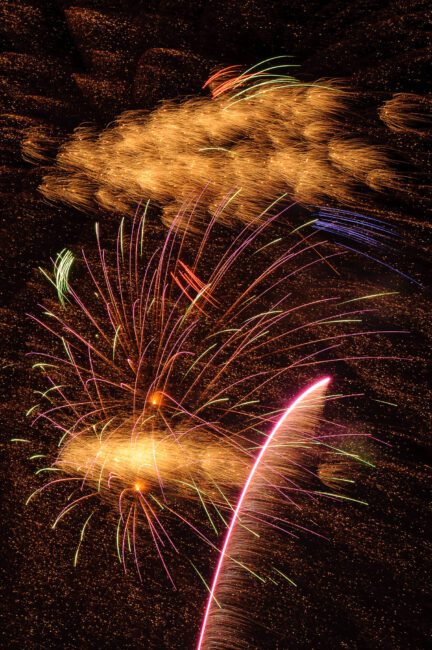
Use Proper Camera Settings
First, set your camera on the tripod and connect the remote shutter release (if available). Then, change the following camera settings:- Flash – make sure to turn flash off, as it won’t have the necessary power to illuminate the foreground anyway.
- ISO – start out by setting your camera ISO to its base ISO level (100 on most cameras) and turn off “Auto ISO“, if you have it turned on.
- Image Format – if your camera has the capability, shoot in RAW format instead of JPEG. This way, you can make adjustments to your photograph later on and do a lot of highlight / shadow recovery.
- White Balance – if you shoot in RAW, set your White Balance to “Auto” (you can change it later in post-processing). If you shoot in JPEG, set your White Balance to “Daylight” – it works well in most cases.
- Long Exposure Noise Reduction – turn it off (if available). Keeping it on will double your exposure time, which is unnecessary.
- Metering – I find matrix / evaluative metering to work the best, especially when shooting wide and including foreground elements.
- Camera Mode – switch your camera mode to “Manual Mode”.
- Shutter Speed and Aperture – set your shutter speed to 3 seconds and aperture between f/5.6 and f/8.
- Image Stabilization – if you are shooting with a camera body or lens that has Image Stabilization (or Vibration Reduction in the Nikon world), you need to turn it off – it is of no use when shooting on a tripod.
Properly Frame Your Shot
If you have not figured out your framing in advance, don’t worry about it before the fireworks begin, especially if you don’t know exactly where fireworks will be shot from. Just observe the sky and once the show begins, start working on framing / composition. You might have to constantly zoom in / out and re-frame your shots, so there is really no set rule for this. If there are brightly lit objects in the scene such as buildings and lights, it might be a good idea to include them as part of your composition. If the foreground is unattractive, it is best to exclude it completely and just focus on the firework explosions.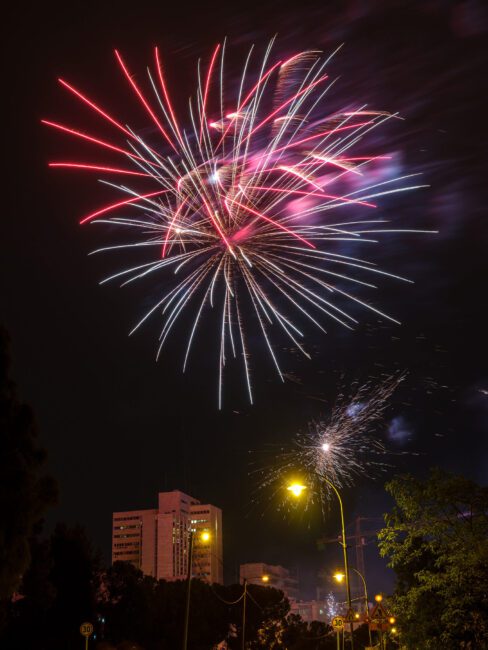
Make sure to straighten the horizon as well when including foreground elements. Lastly, consider both horizontal and vertical framing for your shot. While a horizontal shot often works great, a vertical shot might be necessary to fit both the fireworks and other elements of the scene in a single shot.
Lastly,
watch out for distracting elements while framing. You do not want
trees, power lines and other distracting subjects crossing the primary
elements of your composition.
Acquire Precise Focus
This part is tricky, because you need to make sure that your focus is correctly acquired, no matter what you are shooting with. Focusing options with point-and-shoot cameras might be limited, so make sure to practice this beforehand. If you have a bright object that you can focus on, zoom in to that area via live view (make sure not to zoom in optically, or it will mess up your framing and your focusing) and try to focus manually. If there is no bright subject that you can focus on, it is best to wait until the fireworks start, since fireworks are very bright and your camera should not have a problem focusing accurately. As soon as your focus is acquired, make sure to turn off autofocus. Once you capture a shot or two, play back and zoom in to make sure that the fireworks appear sharp.Focus and Turn off Autofocus
If you are shooting a DSLR or an advanced mirrorless camera, start out by setting your lens focus to infinity and then take a picture. Many modern lenses allow focusing “beyond infinity”, which might screw up the focus on your images. What I typically do to make sure that my focus is 100% accurate, is focus on a bright explosion using the camera’s autofocus system (by half-pressing the shutter release button or pressing the “AF-ON” button), then once the focus is properly acquired, I turn autofocus off completely. Turning off autofocus should be very simple – many lenses will have a focusing switch on their side that allow you to easily turn AF on and off. Since I do not move, my focus from that point on will be accurate and won’t change, unless I zoom in / out with my lens to change my framing.Include Foreground Elements
If you are trying to incorporate interesting foreground elements in your shot and your foreground elements are very close, you might get disappointed to see that you cannot get both the foreground and the fireworks in perfect focus. The first recommendation would be to properly calculate hyperfocal distance, so that you have both the foreground and the background in focus.However, if it is too dark and you do not have a flashlight that you can use to properly calculate the hyperfocal distance, or if all this sounds too complex for you, simply focus on your foreground elements and take a shot. Just make sure that you properly expose the foreground – don’t worry about the fireworks in the distance. After you take one or two shots where the foreground looks good, re-acquire focus on the fireworks without changing your composition and keep on shooting. This way, you will have two separate exposures – one for the foreground and one for the background, which you can blend later on in post-processing.
Control Shutter Speed
When the fireworks show begins, take a picture during a bright explosion and see if the image is underexposed or overexposed. If the image is too dark or too bright, use your camera’s shutter speed to change the exposure length. Since you are shooting in manual mode, it should be pretty easy to do that. Your aperture does not matter for the most part – it is the shutter speed that will be controlling how much light enters your camera. For some fireworks, you will find that it is better to have shorter shutter speeds, while for others, a longer shutter speed might be necessary to capture the trails coming from each explosion.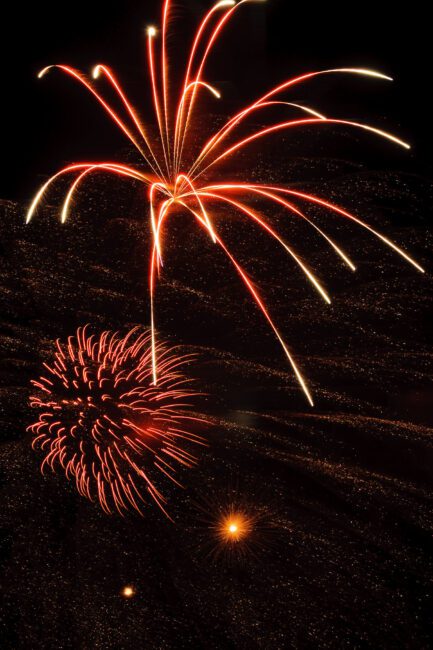
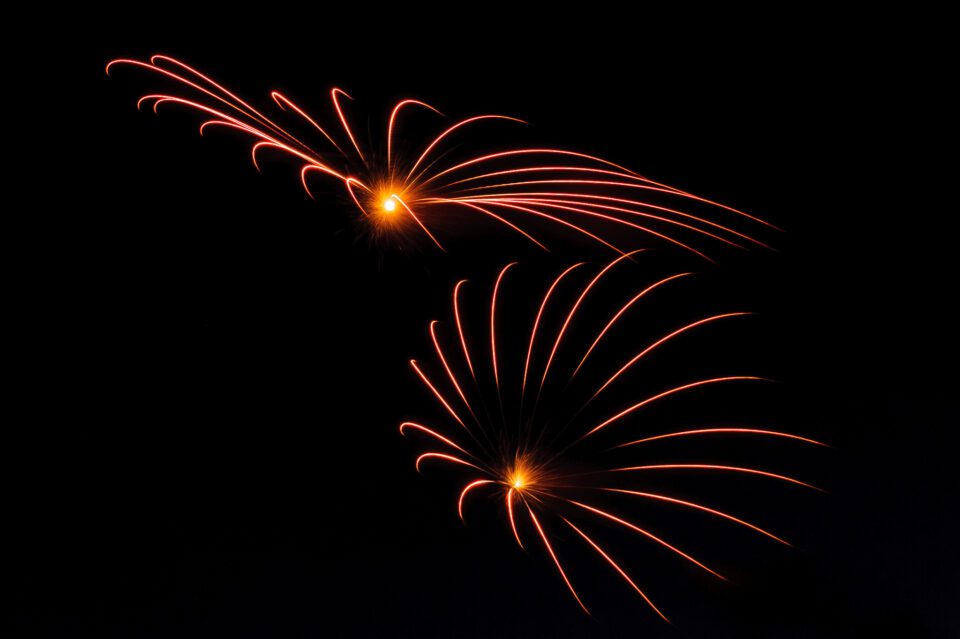
You
don’t want the exposure time to be too long, because the sky will
brighten up and the smoke might become too visible (ideally, you want
the sky to look pitch black).
As the fireworks show gets closer to
its “culmination” phase, you will notice that it is going to get very
bright. Make sure to adjust your shutter speed accordingly (sometimes to
a fraction of a second) to avoid overexposing your images.Use “Bulb” Mode
If you have a remote shutter release and your camera supports “Bulb” in Manual Mode, try it out by opening up the shutter at the beginning of the explosion and then release it as soon as it ends. This is the preferred method over the manual method above, as it allows you to precisely control when the shutter opens and closes as you photograph fireworks. Since firework sequences and their lengths vary by a great deal, you are going to be better off with the “Bulb” mode, since you are in full control of the exposure time and you can visually see what’s going on.If you do not have a remote shutter release, you can still use the bulb mode by holding on the shutter release of your camera and then releasing it at the end of the sequence. However, since you are shooting at slow shutter speeds, you have a very high chance of introducing camera shake. Therefore, it is ideal to use the “Bulb” mode with a remote shutter release, so that you keep your hands off your camera.
Here are the basic steps for using the “Bulb” mode:
- Connect remote shutter release to your camera.
- Frame your shot and set desired focal length on the lens.
- Properly acquire focus using step #8 above.
- Set your camera to “Bulb” mode (changing exposure time beyond 30 seconds usually reveals the “Bulb” mode).
- Take a picture by holding the shutter release button on the remote shutter release. Keep holding until the firework sequence ends and release the button right after.
- Play back the image on the camera’s LCD and make sure that the fireworks are properly focused and exposed.
Watch Out for Wind Direction
Fireworks generate quite a bit of smoke and you do not want too much of it in your images, or your fireworks images will look quite bad. Believe it or not, but the ideal condition for photographing fireworks is a slightly windy night! If there is a little bit of wind, find the direction of the wind and try to stand in parallel direction, so that the smoke moves out of your frame and doesn’t end up behind the fireworks or in front of you.
If
it is a calm day and there is no wind, then try to focus on the initial
explosions – they are probably going to give you the best results.
Towards the end of the show, you will probably deal with way too much
smoke everywhere, so your best bet might be to shoot shorter exposures
and just focus on parts of the explosion. With shorter exposures, you
will end up with less smoke in your images.
Photo Challenge
Here is a photo challenge for you – using the above tips, go out and photograph fireworks at a local fireworks show. Pick your best photo of the day, then post a link to it in the comments section below.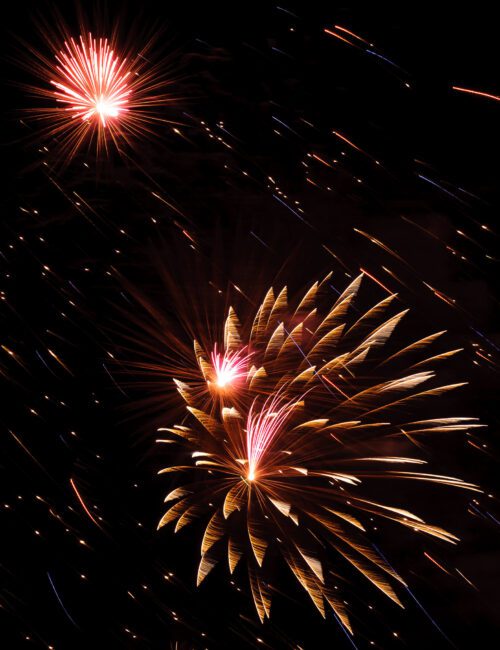
No comments:
Post a Comment
Note: Only a member of this blog may post a comment.